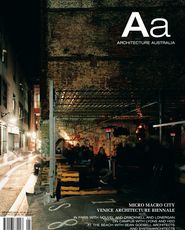Paolo Tombesi considers the current and potential roles of government architects.
What are the possible roles of the government architect in contemporary Australia? At the end of May, the University of Melbourne hosted a public discussion among the recently appointed representatives of the government architect offices of Victoria (John Denton and Shelley Penn), New South Wales (Peter Mould and Peter Poulet), Western Australia (Geoffrey London) and Queensland (Wayne Petrie).
Developed under the aegis of the 2005 RAIA Sisalation Prize, the meeting provided an opportunity for the public to learn about the office of the government architect in Australia, how its nature changes from state to state, and how this is reflected in the position of the office within the bureaucracy of government.
In fact, those sitting at the May round table represented operational units ranging from less than five to over 150 employees, located within the Department of Premier and Cabinet (Victoria), the Department of Public Works (Queensland), the Department of Housing and Works (Western Australia), and the Department of Commerce (New South Wales).
The discussion clarified how, in such varied contexts, institutional consistency is provided by the official terms of reference of each office, all of which, by and large, can be summarized as design advice to government and “good design” advocacy within the community. As these terms imply, the function tends to be consultative rather than deliberative, defining a role that enables the office to behave autonomously and remain independent of the respective raisons d’état, but which also limits its ability to develop and carry out directly the policies it supports or has instigated.
As the panel participants intimated, the government architect offices in Australia are poised to affect the quality of the built environment cunningly, by influencing the procurement strategies of civic work through high-level consulting and by raising the architectural (good design) awareness of public and government through demonstration projects, information programmes and strategic research. In playing the part of intellectual facilitator rather than public servant tied to the inner workings of bureaucracy, Australia’s government architects draw intentionally close to successful European profiles, such as the Chief Government Architect of the Netherlands or the Commission for Architecture and the Built Environment (CABE) in the UK – offices that have become influential because of their cultural profile and consequent political support rather than straight legislative power.
A question, however, lingers. Is raising the public’s awareness of architecture and its role in the city an ambitious enough mission for government architects in Australia? Let me rephrase: is the urban acupuncture implied in their programmes sufficient to look after the quality of the growing metropolitan body, or is it also necessary to work on the basic diet of Australian cities by prescribing what ingredients they should work with?
One wonders, in fact, how long it will take for enlightened design advice and advocacy percolating from the top to make a difference in the private design and construction market, a market that contributes to the definition of urban/ environmental quality (or the lack thereof) at least as much as public or civic work.
Should government architects, therefore, get directly involved? Might they contribute to drafting legislation concerning real estate practices, private residential or commercial development, even “good design” guides, as part of their affirmed stake in raising qualitative outcomes? Or are such activities inherently political, and hence destined to be treated as such by governments overly aware of the role of construction within the economy, and consequently preoccupied with maintaining industrial allegiances?
The discussion in Melbourne showed that these are real issues, part of the internal debate of the Government Architects Network Australia (GANA) and still in a fluid state of investigation. The older, and thus more established, offices have taken some exploratory steps in such a normative direction and the others are following suit.
In a sense, the very emphasis on “design” responsibilities betrays the sensitivity of the government architect role and the fragility of the position vis-a-vis competing urban interests. No matter how important and necessary the government architect’s function is, waving the lofty banner of good design while only partially engaging with the mechanics or outcomes of generic building gives planning and construction the chance to be let off the proverbial hook.
Indeed, the limited job description of the government architect reflects the almost total separation (if not outright conflict) that exists in Australia between architecture and construction debates, research and policies.
From this point of view, the government architect offices may have to look further than their British or Dutch counterparts, and possibly towards France’s Plan Urbanisme Construction Architecture (PUCA), an organism set up by the Ministry of Transport, Infrastructure and Tourism thirty years ago to design policies, fund programmes and develop technologies to help architecture, building and cities grow together. Among other things, PUCA’s work produced Europan, the world’s most important competition scheme for young architects, and the areas of controlled development (ZACs) plan for social housing. It also sponsors research on new materials, building systems, delivery methods and programme assessment.
In line with the best transalpine tradition, PUCA maintains its autonomy from within the government while using its own embedding to reach different agencies and inform their practice. During question time in Melbourne, much of the audience – comprising local government officials as well as architectural practitioners – expressed the need and the desire for a similarly multi-level government architect office, one which would encourage new ideas but also assist in the construction of a sympathetic bureaucratic culture, the training of its officers, and the facilitation of efficient due processes.
The reference to PUCA, a nationally established organization, also raises the issue of scale and critical mass. Is it time for an Australian Government Architect appointment – one with the breadth and the resources to promote and facilitate, at a national level, debate about, and harnessing of, those aspects of built environment thinking that are currently fragmented?
The discussion ought to continue.PAOLO TOMBESI IS ASSOCIATE PROFESSOR OF ARCHITECTURE AT THE UNIVERSITY OF MELBOURNE. WITH BLAIR GARDINER AND TONY MUSSEN, HE IS THE RECIPIENT OF THIS YEAR’S SISALATION PRIZE LOOKING AHEAD: DEFINING THE TERMS OF A SUSTAINABLE PROFESSION.















